Related Research Articles
Events from the year 1870 in art.

Raja Ravi Varma was an Indian painter and artist. His works are one of the best examples of the fusion of European academic art with a purely Indian sensibility and iconography. Especially, he was notable for making affordable lithographs of his paintings available to the public, which greatly enhanced his reach and influence as a painter and public figure. His lithographs increased the involvement of common people with fine arts and defined artistic tastes among the common people. Furthermore, his religious depictions of Hindu deities and works from Indian epic poetry and Puranas have received profound acclaim. He was part of the royal family of erstwhile Parappanad, Malappuram district.
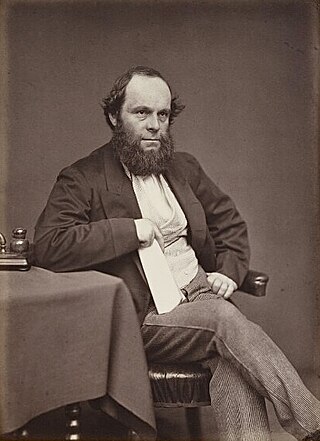
Richard Plantagenet Campbell Temple-Nugent-Brydges-Chandos-Grenville, 3rd Duke of Buckingham and Chandos,, styled Earl Temple until 1839 and Marquess of Chandos from 1839 to 1861, was a British soldier, politician and administrator of the 19th century. He was a close friend and subordinate of Benjamin Disraeli and served as the secretary of state for the colonies from 1867 to 1868 and governor of Madras from 1875 to 1880.
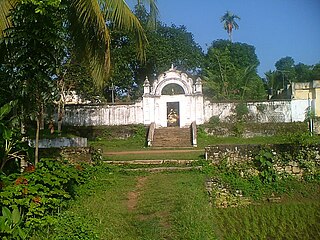
Kilimanoor Palace is a palace located in Kilimanoor, in the Indian state of Kerala. It is the birthplace of painter Raja Ravi Varma and Raghava Varma, the father of king Marthanda Varma.

C. N. Karunakaran was an Indian painter, illustrator and art director from Kerala. He was the Chairman of the Kerala Lalitakala Academy and a recipient of several honours including the Kerala Lalithakala Akademi Award which he won thrice. The Akademi honoured him again with the fellowship in 2005.

Karuvattu Mana Vasudevan Namboothiri, better known as Artist Namboothiri or simply Namboothiri, was an Indian painter and sculptor, known for his line art and copper relief works. He illustrated for many Malayalam writers such as Thakazhy Shivasankara Pillai, Kesavadev, M. T. Vasudevan Nair, Uroob, S. K. Pottekkatt, Edasseri Govindan Nair, and V.K.N., and was one of the most prolific literary illustrators of India. He was also a chairman of the Kerala Lalithakala Akademi. The Akademi awarded him the Raja Ravi Varma Award in 2003. He was also a recipient of the Kerala State Film Award for Best Art Director.
Vattaparambil Sankaran Valiathan, commonly referred to as Artist V. S. Valiathan, was an Indian artist from Pandalam, Travancore who was known for his classical style of painting in the Raja Ravi Varma tradition. His paintings show muted colours and natural overtones.

Rang Rasiya, titled Colours of Passion in English, is a 2014 Indian drama film written and directed by Ketan Mehta, based on the life of the 19th century Indian painter Raja Ravi Varma. It was released bilingually in Hindi as Rang Rasiya and in English as Colours of Passion. The film was a cinematic adaptation of the novel Raja Ravi Varma by Ranjit Desai. It stars Randeep Hooda as Raja Ravi Varma and Nandana Sen as his love interest.
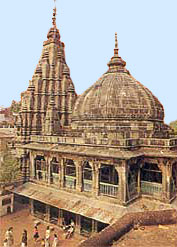
Vishnupad Temple is an ancient Hindu temple dedicated to Vishnu in Gaya, Bihar, India, located on the banks of Phalgu river. The temple is believed to be built upon the site where Vishnu had purportedly killed the demon Gayasura or pinned him underground. The temple features a 40-cm footprint purported to be of Vishnu incised into a block of basalt, known as Dharmasila which was retained when the deity stepped on Gayasura's chest before pinning him underground.
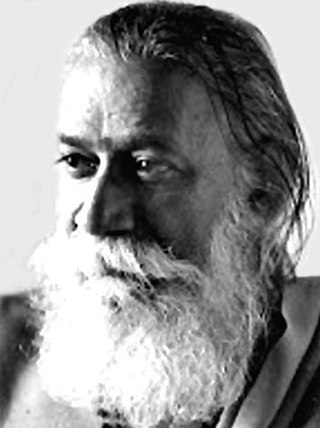
Sambanand Monappa Pandit was an Indian painter from Karnataka, popular in the school of Realism in contrast to the contemporaneous net-traditionalist Bengal Renaissance and other Indian modern art movements of his time. Most of his subjects oscillated between events from classical Indian literature including the Ramayana, the Mahabharata, the Puranas, and the contemporary cinema of his times. He infused a rare blend of artistic virtuosity and filmi glamour to his portrayal of romantic characters like Radha-Krishna, Nala-Damayanti, and Viswamitra-Menaka as also the many heroes and heroines of Hindi cinema. In addition to his critically acclaimed masterpieces he also illustrated many popular film posters, film magazines and various other publications in what can collectively be termed as calendar art. His works remain hugely popular even today. His mythological paintings and calendar art have been collected widely. He is also widely celebrated in the Indian calendar industry for his "realistic" depiction of themes from Hindu mythology. In these paintings he emphasised the physical forms of the heroes, heroines, gods and goddesses in marked contrast to traditional and classical styles of Indian painting. In his paintings, Pandit depicted his subjects as handsome, muscular, valorous men and sensuously beautiful, voluptuous women set in surroundings suggestive of cinema settings and sceneries.

Narottam Narayan Sharma was an Indian artist from Nathdwara. He is especially famous for his images of Krishna, which were popular throughout North India and were even more influential than the works of Raja Ravi Varma.

Makaramanju is a 2011 Malayalam language romantic drama film written and directed by Lenin Rajendran. The film is about a certain stage in the life of a celebrated painter, Raja Ravi Varma. It also narrates the story of the epic character, Pururavas. Cinematographer Santhosh Sivan and Karthika Nair appear in the lead roles. The movie is the latter's major Malayalam debut.
Ravi Varma Raja was a Samantan Nair warrior prince of the Royal House of Zamorins from Calicut who fought a two-decade long revolt against the Mysore Sultanate under Hyder Ali and Tipu Sultan between 1766–1768 and 1774–1791, and later the British East India Company in 1793.

The modern Indian art movement in Indian painting is considered to have begun in Calcutta in the late nineteenth century. The old traditions of painting had more or less died out in Bengal and new schools of art were started by the British. Initially, protagonists of Indian art such as Raja Ravi Varma drew on Western traditions and techniques including oil paint and easel painting. A reaction to the Western influence led to a revival in primitivism, called as the Bengal school of art, which drew from the rich cultural heritage of India. It was succeeded by the Santiniketan school, led by Rabindranath Tagore's harking back to idyllic rural folk and rural life. Despite its country-wide influence in the early years, the importance of the school declined by the 'forties' and now it is as good as dead.
C. L. Porinchukutty was an Indian artist and art educator. He was born in Thrissur in the erstwhile state of Cochin in 1932. He practised art under the tutelage of veteran artist P. I. Ithoop, a disciple of Abanindranath Tagore. After attaining a Diploma in Painting from the Government of Madras, he took a degree in English literature from the University of Kerala and Post-Graduation in Painting with Gold Medal from the University of Udaipur, Rajasthan.

Anjanibai Malpekar was a noted Indian classical singer, belonging to the Bhendibazaar gharana of Hindustani classical music.
C. Kodiya Raju was a popular Calendar artist well known for his depictions of Hindu Gods and Goddesses in a typical style, amalgamating the features of contemporary calendar art and traditional South Indian paintings. He reached the peak of his fame during the heyday of the lithographic printing presses in Sivakasi. Kondiah Raju has an important place in the evolution of Indian Calendar art, which gained popular attention with Ravi Varma and continued on through artists such as S. M. Pandit, Mulgaonkar and others in the 20th century. In addition to his painting skills he also displayed a spiritual streak, as also a starkly austere simplicity, that prompted many of his students to call him an 'artist-saint'.

Nair lady Adorning Her Hair is an 1873 painting by Raja Ravi Varma. The painting depicts a domestic scene in which a Nair woman adorning her hair with a garland of flowers in front of a mirror. The painting was notable for being the first major award-winning work that Ravi Varma had completed. Receiving praise at the international and national level, the painting had brought the young Ravi Varma into the attention of the global artistic community, as well as leading him on to later become one of the most well known modern Indian painters.
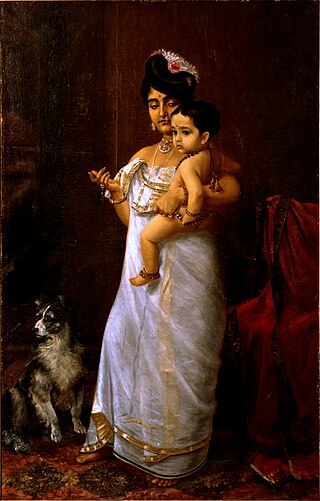
There Comes Papa is an 1893 painting by the Indian artist Raja Ravi Varma. The painting focuses on Varma's daughter and grandson, looking towards the left at an approaching father. Evoking both Indian and European style, the painting has been noted by critics for its symbolism regarding of the Nair matrilineal practices.
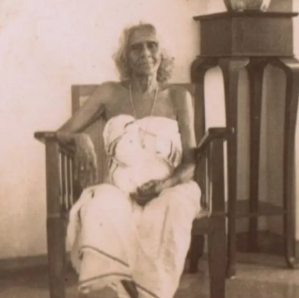
Mangala Bayi Thampuratti (1865–1954), known as Mangala Bayi, was an artist from Kerala, India, whose portraits depicted primarily domestic and devotional themes in everyday life in Travancore. She belonged to the Travancore royal family, and her brother, Raja Ravi Verma, was also a renowned Indian painter.
References
- ↑ Kumar, R. Siva. "Varma, Ravi" . Oxford Art Online. Oxford University Press. Retrieved 25 November 2015.
- ↑ C. Raja Raja Varma (2005). Erwin Neumayer; Christine Schelberger (eds.). Raja Ravi Varma, portrait of an artist : the diary of C. Raja Raja Varma. New Delhi: Oxford university press. ISBN 9780195659719.
- ↑ Mitter, Partha (1994). Art and Nationalism in Colonial India, 1850-1922: Occidental Orientations. Cambridge University Press. pp. 69, 193, 208. ISBN 978-0-52144-354-8.
- Kilimanur Chandran, Raja Ravi Varmayum Chithrakalyum, Department of Cultural publications, Government of Kerala, 1999. (in Malayalam)
- Portrait of an artist [usurped]